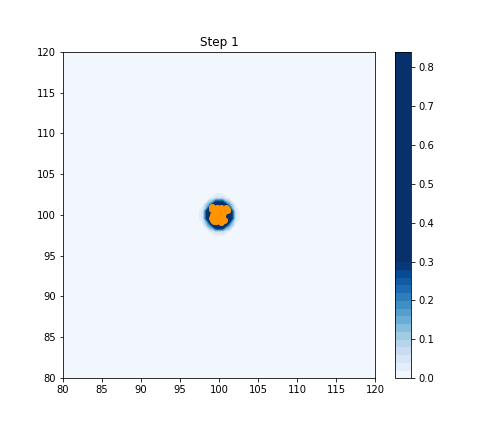Live update jupyter plot
import matplotlib.pyplot as plt
from IPython.display import display, clear_output
%matplotlib inline
fig, ax = plt.subplots(1, figsize=(6, 6))
for _ in range(100):
ax.cla()
# ax.plot your things here
display(fig)
clear_output(wait=True)
2D random walk example
Lets see a concrete example simulating a simple 2D random walk:
import numpy as np
import matplotlib.pyplot as plt
from IPython.display import display, clear_output
%matplotlib inline
np.random.seed(42)
def probability(XY, N):
radius= np.sqrt((XY[0]-100)**2 + (XY[1]-100)**2)
return 2*radius/N * np.exp(-radius**2/N)
NBALLS = 30
NSTEPS = 100
balls = np.ones([NBALLS,2])*100
fig, ax = plt.subplots(1, figsize=(7, 6))
for step in np.arange(1, NSTEPS+1):
ax.cla()
balls = balls + np.random.uniform(-1, 1, balls.shape)
x_grid = np.linspace(80, 120, 50)
y_grid = np.linspace(80, 120, 50)
XY = np.meshgrid(x_grid, y_grid)
cf = ax.contourf(x_grid, y_grid, probability(XY, step), 50, cmap='Blues', vmin=0, vmax=0.3)
color = (np.array([1, 0.6, 0])*np.exp(-step/30) + np.array([1, 0, 0])*(1-np.exp(-step/30)))
for ball in balls:
ax.scatter(ball[0], ball[1], color=color)
ax.set_xlim(80, 120)
ax.set_ylim(80, 120)
ax.set_title(f'Step {step}')
if step==1: fig.colorbar(cf)
display(fig)
clear_output(wait=True)
#fig.savefig(f'imgs/img{step}.png')
